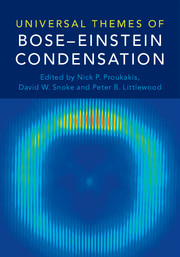Book contents
- Frontmatter
- Contents
- Foreword
- Preface
- Part I Introduction
- 1 Universality and Bose-Einstein Condensation: Perspectives on Recent Work
- 2 A History of Bose-Einstein Condensation of Atomic Hydrogen
- 3 Twenty Years of Atomic Quantum Gases: 1995-2015
- 4 Introduction to Polariton Condensation
- Part II General Topics
- Part III Condensates in Atomic Physics
- Part IV Condensates in Condensed Matter Physics
- Part V Condensates in Astrophysics and Cosmology
- Universal Bose-Einstein Condensation Workshop
- Contributors
- Index
- References
1 - Universality and Bose-Einstein Condensation: Perspectives on Recent Work
from Part I - Introduction
Published online by Cambridge University Press: 18 May 2017
- Frontmatter
- Contents
- Foreword
- Preface
- Part I Introduction
- 1 Universality and Bose-Einstein Condensation: Perspectives on Recent Work
- 2 A History of Bose-Einstein Condensation of Atomic Hydrogen
- 3 Twenty Years of Atomic Quantum Gases: 1995-2015
- 4 Introduction to Polariton Condensation
- Part II General Topics
- Part III Condensates in Atomic Physics
- Part IV Condensates in Condensed Matter Physics
- Part V Condensates in Astrophysics and Cosmology
- Universal Bose-Einstein Condensation Workshop
- Contributors
- Index
- References
Summary
The study of Bose-Einstein condensation has undergone a remarkable expansion during the last twenty years. Observations of this phenomenon have been reported in a number of diverse atomic, optical, and condensed matter systems, facilitated by remarkable experimental advances. The synergy of experimental and theoretical work in this broad research area is unique, leading to the establishment of Bose-Einstein condensation as a universal interdisciplinary area of modern physics. This chapter reviews the broad expansion of Bose-Einstein condensation physics in the past two decades.
Introduction
The field of Bose-Einstein condensation (BEC) has undergone an explosive expansion during the past twenty years. Newcomers to this field are now often introduced to this as a universal phenomenon, which nonetheless exhibits diverse (and sometimes strikingly different) manifestations. Despite such differences, the common underlying theme creates a unique identity across many different energy and length scales.
The study of BEC as a universal phenomenon was highlighted in a focused conference in 1993, leading to the publication of the well-known “green book” [1], which surveyed the breadth of the field of condensate physics at that time. The success of the conference led to a second meeting in 1995, at which Eric Cornell and Carl Wieman announced the achievement of Bose-Einstein condensation of ultracold 87Rb atoms in a harmonic trap. That work began an explosion of new research in the field of cold atoms, which has continued to this day, and this very success inevitably led many of those studying cold atoms to pay less attention to other types of condensates. Wolfgang Ketterle gives a historical overview of this exciting period of time in Chapter 3. Recently, various scientific meetings have worked to re-establish the physical connections across different BEC systems, and in 2013 a workshop was held with the focused goal of improving communications across disciplines. This present book is an outgrowth of that meeting.
The Situation Before the Revolution
Because of the great success of the cold atom BEC and other BEC systems in the past twenty years, it may be hard for young scientists to understand the climate of BEC research in the early 1990s. At that time, there was only one known example of BEC, namely liquid helium-4, and there was a small but vocal minority of scientists who questioned whether BEC was established even in that system.
- Type
- Chapter
- Information
- Universal Themes of Bose-Einstein Condensation , pp. 3 - 21Publisher: Cambridge University PressPrint publication year: 2017



